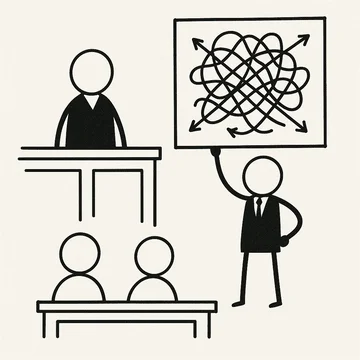We've talked a lot about "plain meaning" constructions, and how our judges have sometimes pushed back against parties who offer plain meaning constructions without any indication of what the actual meaning of the term is.
Magistrate Judge Fallon issued an R&R today on an offshoot of this issue. In PPC Broadband, Inc. v. Charles Industries, LLC, C.A. No. 22-1517-GBW-SRF (D. Del. Jan. 8, 2024), the parties disputed the construction of only a single term, "drop cable." Plaintiff proposed not construing the term at all, and offered a generic definition as an alternative. The defendant proposed a specific construction that added limitations to the claim.
The patent at issue is directed towards a wall-mounted box that sits in a building and receives a fiber optic cable and splits it out into multiple sub-cables to go other places in the building. It looks like this:

The item marked 110, circled in red, is the "drop cable." According to the opinion, it's the cable that brings fiber optic service into the building. The box then splits the signal from that cable onto other cables, including "feed" and "distribution" cables, to distribute the service to other locations in the building.
The dispute between the parties is whether "drop cable" needs to be construed at all. Here are the parties' proposed constructions:
Plaintiff: No construction necessary, or in the alternative to the extend construction is necessary: "a cable that connects the drop interface box to an optical fiber service provider"
Defendant: "externally jacketed (e.g., heavy, hardened, or outdoor jacket) multi-fiber cable"
Id. at 7.
The claim includes "drop cable" in several places:
1. A drop interface box configured to be mounted to a structure and to receive a drop cable from an optical fiber service provider distribution point and a plurality of distribution cables which distribute the optical fiber service, the drop interface box comprising:
a base unit having a drop cable entrance configured to receive the drop cable and having drop cable retaining mechanisms spaced apart and configured to retain a length of drop cable looped around the drop cable retaining mechanisms;
a cover having a hinged connection to the base unit to selectively enclose a storage area provided in the base unit; and
a fiber storage panel having a hinged connection to the base unit on a side opposite the hinged connection of the cover to the base unit such that the fiber storage panel is moveable relative to the base unit and configured to be stored between the base unit and the cover, the fiber storage panel having first spools positioned to store a plurality of feed break-out cables coupleable to the drop cable, the fiber storage panel further having second spools positioned to store a plurality of distribution cables coupleable to the plurality of feed break-out cables.
The Court examined "whether the term 'drop cable' is a limiting term requiring construction." It determined that it is not, because the device need not include an actual "drop cable" to infringe:
I recommend that the court find the term “drop cable” is not a structural limitation requiring a construction by the court. . . . [C]laim 1 of the ’483 patent describes the “drop cable” as a non-limiting reference point to explain the configuration of the [patented drop interface box ("DIB")]. Just as the claimed beverage brewing device in [Eko Brands, LLC v. Adrian Rivera Meynez Enterprises, Inc., 946 F.3d 1367,1376 (Fed. Cir. 2020)] was configured to receive a single serve beverage brewer, and the housing in [C.R. Bard, Inc. v. M3 Sys., 157 F.3d 1340 (Fed. Cir. 1998)] provided a reference point for defining the claimed needles, the DIB of the ’483 patent recites “a base unit having a drop cable entrance configured to receive the drop cable.” . . . As long as the DIB and its associated components are capable of receiving the drop cable, the claim requirements are met and the presence or lack of an actual drop cable in the DIB is irrelevant. See DSC Commc'ns Corp. v. Pulse Commc’ns, Inc., 170 F.3d 1354,1368 (Fed. Cir. 1999) (explaining that asserted claims 2 and 5 of U.S. Patent No. 5,263,081 “do not require that the claimed apparatus actually include a ‘telephone instrument’; the pertinent language simply requires the apparatus to provide POTS-type service that uses DC signaling to a telephone instrument.”). Consequently, no construction of the term “drop cable” is needed.
The Court then rejected the idea that it was required to construe the term under O2 Micro, for the same reason:
Defendants cite O2 Micro International Ltd. v. Beyond Innovation Technology Co., Ltd., for the general principle that the court has a duty to resolve a fundamental dispute regarding the scope of a claim term. 521 F.3d 1351, 1361-62 (Fed. Cir. 2008) . . . . For the reasons set forth above, however, the specification does not support Defendants’ position that the term "drop cable” limits the scope of the DIB.
Finally, the Court further noted that the defendants' construction would have improperly imported limitations from the specification.
The definition of "not limiting" that Judge Fallon applied in this R&R is potentially useful in some cases, assuming it is adopted by the district court. I imagine that some will argue that any language used to define the features of a structure is not limitingk, as long as that language is not part of the structure itself.
The claim, for example, requires "drop cable retaining mechanisms spaced apart and configured to retain a length of drop cable," and "spools positioned to store a plurality of feed break-out cables coupleable to the drop cable." Despite limitations like these, the Court found "drop cable" to be non-limiting. It will be interesting to see how this case develops and how the parties and how the Court treat the remaining portions of the claim.
If you enjoyed this post, consider subscribing to receive free e-mail updates about new posts.





